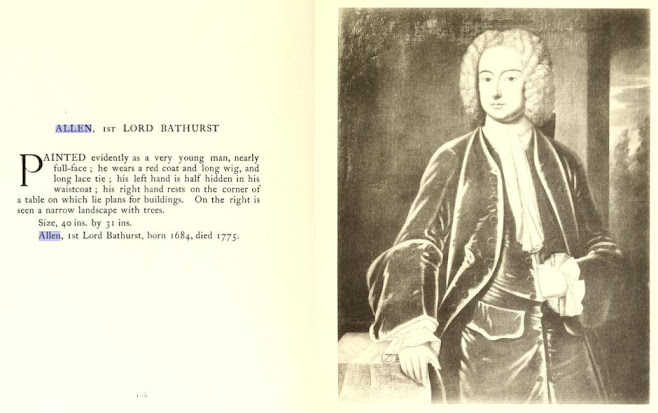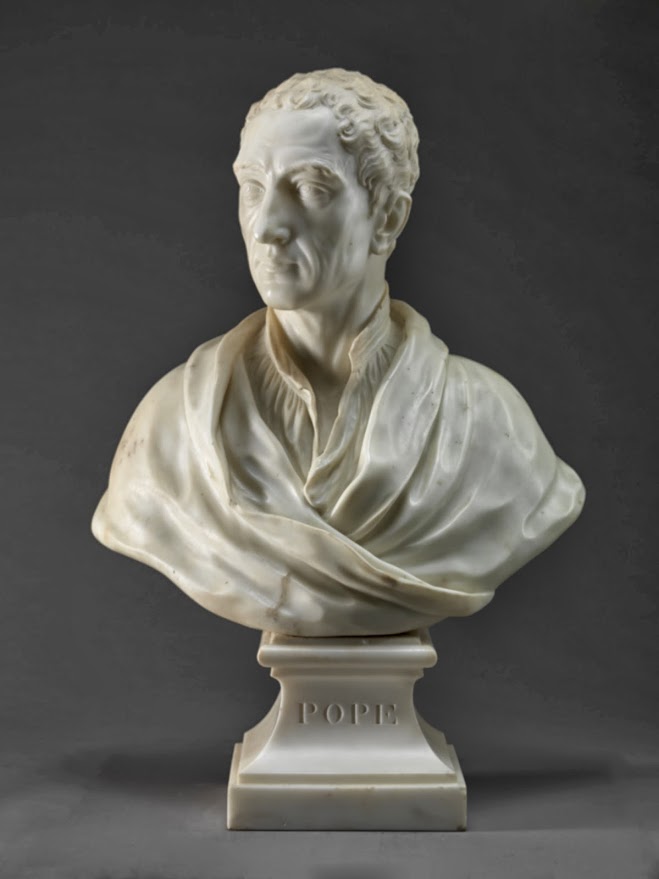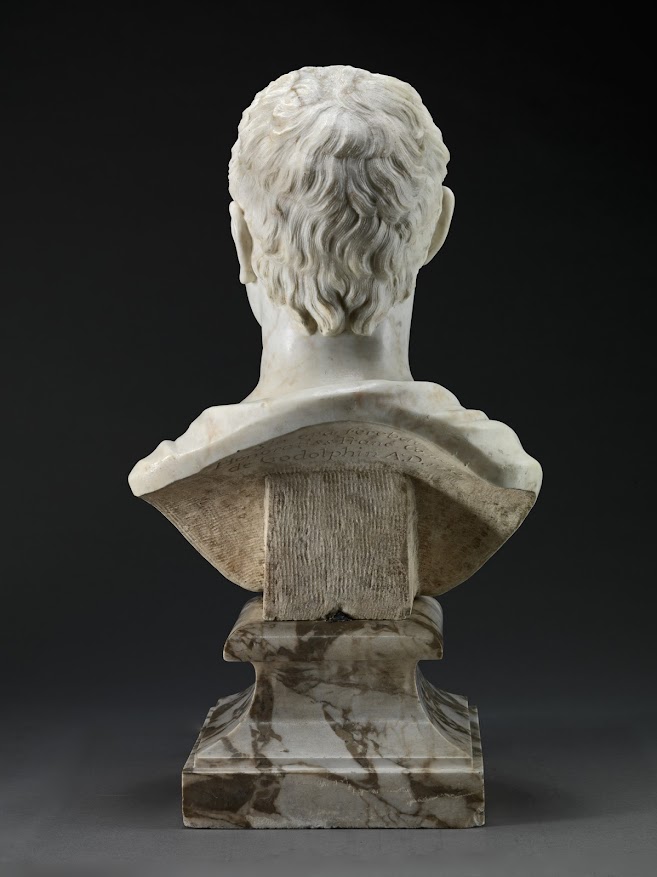An Anonymous Marble Bust.
at the Lady Lever Art Gallery.
Attributed to Peter Scheemakers (1691 - 1781).
By a process of elimination, if indeed the Lady Lever Gallery bust is from this series, from the Temple of Friendship at Stowe - then it can only be that of Richard Grenville Temple, later Earl Temple (1711 - 79).
So a tentative identification here, for this bust as Richard Grenville Temple (1711 - 79).
For Scheemakers biog and works see - Walpole Society Journal Vol LXI - Peter Scheemakers by Ingrid Roscoe - The Stowe busts are not mentioned.
__________
Some rough notes on Scheemakers busts and the Temple of Friendship at Stowe - by no means definitive:
Much of the information here has been culled from the very excellent Peter Scheemakers by Ingrid Roscoe, in the Walpole Society Journal, 1999. LXI.
This bust is related those originallys from the Temple of Friendship at Stowe, Buckinghamshire.
sold at the Stowe Sale -21 August 1848.
Possibly one
of ten busts commissioned by Lord Cobham (1675-1749) for his Temple of
Friendship at Stowe, Buckinghamshire.
Cobham, Chesterfield, Prince of Wales, William Pitt in situ by 1742.
Lords Westmoreland, Gower, Marchmont, Bathurst, Richard Grenville and George Lytteton had arrived by 1745.
_____________________
The Temple of Friendship at Stowe House, Buckinghamshire.
Built 1739.
The Temple of Friendship was built to the design of the
architect James Gibbs (1682-1754). The busts, representing Lord Cobham and his
political friends, stood on pedestals around the room and showed all the sitters in
Roman dress.
1. Sir George Lyttelton, Lord Lyttelton (1709 -73).
2. John Fane Earl of Westmoreland, Marble Bust by Thomas Adye.
3. Frederick Prince of Wales, Royal Collection.
4. Mr Richard Grenville Temple, later Earl Temple (1711 - 79).
5. Hugh Hume, Earl of Marchmont.
6. John Leveson.1st Earl Gower.
7. Allen Bathurst, First Lord Bathurst (1684 - 1775).
______________________
The description below was lifted from the National Trust Website
https://heritagerecords.nationaltrust.org.uk/HBSMR/MonRecord.aspx?uid=MNA129275
"The temple was designed by Gibbs and built in 1739 as a
meeting place for Lord Cobham and his friends. Originally it contained busts of
Cobhams political allies and allegorical paintings. The facade was raised in
about 1760 either to match in scale the remodelled Queen's Temple which it
faces or to keep in scale with the trees on either side.
The inside and the roof of the building were destroyed by
fire and it is now maintained as a ruin.
Ruined Tuscan temple. 1739 by Gibbs. Large building with
portico, semi- circular arched doorway flanked by blank arches, and two open
arches each side of portico. Facade rises above portico with central inscribed
tablet flanked by roundels, moulded cornice with four stone balls.
Despite its apparently universal dedication ‘Amicitiae
S.—’ (‘Sacred to Friendship’), the temple was built for a small and particular
group of friends. In 1737 Lord Cobham invited Frederick, Prince of Wales to
stay at Stowe. For those Whigs who went into Opposition after the Excise Crisis
of 1733 (known as the ‘Boy Patriots’ or ‘Cobham’s Cubs’ and consisting mainly
of Lord Cobham’s nephews), Prince Frederick came to embody the ideal of the
‘Patriot King’ in contrast to the rule of his father George II, and it was
partly in commemoration of the visit that the Temple of Friendship was begun in
1739, the date inscribed on the outside with the dedication.
It was designed by James Gibbs as the first commission of
his second period of employment at Stowe. Standing on the bastion created by
Bridgeman at the eastern end of his southern terrace, it balanced Kent’s Temple
of Venus at the opposite end. The open arches to either side of the central
block recall earlier belvederes at Stowe: Gibbs’s Boycott Pavilions and Temple of Fame (later the Fane of Pastoral Poetry, and the
pavilions at either side of the Temple of Venus. Sarah Bridgeman’s plan of 1739
shows how the avenues just south of the ha-ha admitted a view from the western
belvedere of the Temple of Friendship to the Temple of Venus, and from the
eastern side there was a view to Stowe Castle.
A more significant relationship was established in 1742–8
with the building of the Lady’s Temple (later the Queen’s Temple, p. 42), which
Gibbs also designed and which faces the Temple of Friendship across the
Hawkwell Field. This was to be the sanctuary of Lady Cobham and her friends,
while her husband’s political cronies resorted to the Temple of Friendship.
This temple is therefore unusual at Stowe in having had a
regular use. It is built over a basement which had a kitchen as well, no doubt,
as ample cellarage. The central block originally had a low, pyramidal roof
topped by an open lantern (see Bickham’s engraving, illustrated below) and
apparently covered with the same black glazed pantiles later used on the Temple
of Concord and Victory.
Within, it was decorated with murals by Francesco
Sleter symbolic of Friendship, Justice and Liberty, as Seeley described in
1747: "Upon the Ceiling is seated Britannia: Labels, inscribed with the
Reigns of Edward 3. and Q. Elizabeth are held on one Side of her; and on the
other is offered the Reign of — [ie George II] which she covers with her
Mantle, and seems unwilling to accept."
Around the walls were placed on tapering pedestals ten
marble busts of members of Lord Cobham’s political circle: Frederick, Prince of
Wales, the Earls of Chesterfield, Bathurst, Marchmont, Chatham, Westmorland and
Gower, Lord Lyttelton, together with Lord Cobham and Earl Temple themselves.
The notches cut into the stone skirting to receive the bases of their black
marble pedestals can still be seen.
_________________
Scheemakers was paid £75 in April 1741 for three of
the busts and pedestals (Lord Cobham, Lord Chesterfield and the Prince of Wales). Lord Cobham's account books Stowe House Huntington Library ST 161 (Roscoe).
Thomas
Adye supplied the bust of Lord Westmorland.
This evidence for this payment needs to be checked - it is possible that Scheemakers had subcontracted some of the work to Thomas Adye.
Defoe in A Tour through the whole island of Great Britain in 1742 noted four busts.
The authorship of the others is
uncertain (all ten were sold in the 1848 sale)".
_____________________
A list of The Ten Marble Busts originally in the Temple of Friendship at Stowe. Buckingham.
with the entry for them from the 1848 Stowe House Sale Catalogue.
For the complete 1848 Stowe catalogue see -
1. Sir George Lyttelton, Lord Lyttelton (1709 -73), (this bust is currently unaccounted for).
Bought at the Stowe sale by Mrs W.E. Gladstone, (wife of Gladstone future Prime Minister) sister of the then Lady Lyttleton, both descendants of the Grenville family.
This bust (if it still exists) should be easily recognisable from the pronounced Roman nose as seen in the portraits
National Portrait Gallery
_____________________
2. John Fane Earl of Westmoreland, the Marble Bust by Thomas Adye.
Photograph courtesy the V and A Museum.
__________________
3. Frederick Prince of Wales, in the Royal Collection.
Frederick Prince of Wales.
81.0 x 51.0 x 25.0 cm
Commissioned by Richard Temple, Viscount Cobham for the Temple of Friendship in the garden at Stowe, Buckinghamshire; by descent to 2nd Duke of Buckinghamshire;
Scheemakers received payment for this bust.
Sold Christie's, 15 August 1848; bought Rainey; Fifth Earl Temple;
by whom sold Sotheby's, London, 9 May 1941;
bought by HM Queen Elizabeth.
Royal Collection Trust / © HM Queen Elizabeth II, 2015.
________________________
4. Mr Richard Grenville Temple, later Earl Temple (1711 - 79).
Possibly the bust pictured below.
The terracotta model for this bust was sold, Lot 25 at the Scheemaker sale of 6 June 1775, along with the model of the missing bust of Bathurst.

The Lady Lever Gallery Anonymous Marble Bust,
Here suggested as possibly that of Richard Grenville Temple.
See further notes and photographs below.
William Hoare.
National Portrait Gallery.
........................................................
Richard Grenville, 2nd Earl Temple.
by Robert Edge Pince, c.
1776.
Oil on canvas.
Stowe House - Buckinghamshire, England.
............................................
Richard Grenville, 2nd Earl Temple.
Allan Ramsay.
1762.
National Gallery of Victoria, Melbourne, Australia.
_________________________
5. Hugh Hume, Earl of Marchmont.
Bought at the Stowe sale by Attenborough?
Hugh Hume, Earl of Marchmont, Marble bust now at Mellestain House.
Here attributed to Adye.
_________________________
6. John Leveson. 1st Earl Gower. (Current location of this bust isunknown).
Bought at the Stowe sale by The Earl of Ellesmere.
Not signed.
In Peter Scheemakers by Ingrid Roscoe in Walpole Society
Journal, 1999, she suggests that this bust is by Scheemakers.
The style and
carving of the socle leads me to believe that it is perhaps more likely to be by Ady(e).
_____________________
7. Allen Bathurst, First Lord Bathurst (1684 - 1775).
Roscoe in Walpole Society Journal 1999 says currently at Cirencester Park.
This needs to be confirmed.
Bought at the Stowe sale by the Earl Bathurst.
Model Terracotta sold 6 June 1771 at Scheemakers Sale, along with similar bust of Grenville (lot 25).
Illustrations above from the Catalogue of the Bathurst Collection of Pictures,
by Bathurst Collection; Bathurst, Seymour Henry Bathurst,
7th Earl, 1864-1943
Allen Bathurst, 1st Earl Bathurst.
by and published by Charles Bestland.
Stipple engraving.
Lettered below image with title, information about the
sitter over one line.
'Engraved by C. Bestland, from a Picture in Enamel, / in
the Possession of Earl Bathurst.' and 'Published June 1, 1803, by C Bestland,
West End, Hampstead.'
Illustration to George Owen Cambridge's 'The Works of Richard Owen Cambridge, Esq.' (London: 1803).
Imager courtesy British Museum.
________________________
8. Richard Temple, Viscount Cobham. 1741.
The Clay Model sold, lot 25. Scheemaker Sale 6 June 1771.
Richard Temple, Viscount Cobham (1675 - 1749).
1741.
Peter Scheemakers.
Inscribed on the Socle P. Scheemakers Ft.
noted in the Temple of Friendship at Stowe by Defoe in 1742.
Scheemakers was paid for this bust.
Victoria and Albert Museum.
________________________
9. William Pitt the Elder, Earl of Chatham (unaccounted for). There is a plaster bust at Chevening which Rupert Gunnis attributed to Scheemakers.
_____________________
10. Philip Dormer Stanhope, Earl of Chesterfield.
Philip Dormer Stanhope, 4th Earl of Chesterfield.
by Peter Scheemakers.
Marble bust.
Height 25" - 63.5 cms.
1741.
Sold Lot 130 in the Peel Heirloom Sale of 10 May 1900.
Hyning Hall sale c.1949.
Dr Ireland of Keswick.
David Young Edinburgh.
Joanna Barnes (Dealer)
Bought 1992 by The Huntington Collection, San Marino.
Huntington Library, Art Collections, and Botanical Gardens.
_____________________
The Stow busts which have not currently not located.
Allen Bathurst first Earl Bathurst, (a bust on the monument in Cirencester Abbey is possibly a version, of this bust - the mezzotint of Bathurst shows an entirely different shaped nose to our bust ).
William Pitt the Elder, the Earl of Chatham (definitely not the bust above - see photographs of the Wilton bust below).
Richard Grenville, Earl Temple, whereabouts unknown - but perhaps the Lady Lever Bust.
Sir George Lyttleton, Lord Lyttleton, the whereabouts unknown (definitely not the bust above - see portraits above).).
__________________________
The Stowe Sale 21st August 1848.
_____________________
The Lady Lever Gallery Marble Bust.
By a process of elimination, if indeed the Lady Lever Gallery bust is from the series of busts, from the Temple of Friendship at Stowe - then it can only be that of Richard Grenville Temple, later Earl Temple (1711 - 79).
Photographs by the author - I am very grateful to the staff at the Lady Lever Gallery for their assistance.
Provenance -
Perhaps purchased at the Stowe Sale.
Maynard family, Little Easton?; Matthias Kerrison?;Sir Edward Kerrison(1774 - 1853).
Lady Bateman Oakley Hall, nr Eye, Suffolk, 1919;
Christie's Lot 162, 10 July 1919.
M. Harris and Sons;
Lady Lever Art,Gallery.
;
___________________________
The Marble Bust of William Pitt the Elder Lord Chatham
by Joseph Wilton
c. 1766.
Height 730 mm.
National Portrait Gallery
There is another of these busts in the National Galleries of Scotland.
Posted here for comparison with the putative bust of Richard Grenville Temple (above), the Stow bust of Pitt the Elder sold to Sir Robert Peel, lot 771, at the Stowe sale is currently unaccounted for.
for more on these busts of Pitt see my blog post:
The Plaster Bust of William Pitt the Elder after Joseph Wilton at Harvard University.
For a brief but informative video of the conservation of this bust see
_______________________
The Scheemakers busts formerly at Staunton Harrold - from Nollekens and his times by JT Smith:
"My amiable and highly-respected friend, Henry Smedley, Esq..
the correctness of whose communications is always implicitly to be depended upon,
has favoured me with the following information concerning some other works of
this Sculptor.
"Sanctuary, October 13, 1827.
"MY DEAR SIR,
"The six busts by Scheemakers, of which I promised you
an account, are in the library at Staunton Harold, the seat of Earl Ferrers,
and are noticed in Nichols's "Leicestershire." They represent, 1.
Hon. Lawrence Shirley, tenth son of first Earl Ferrers. 2. Anne his wife,
daughter of Sir Walter Clayes, Bart., and four of their children, viz.: 3,
Lawrence, afterwards fourth Earl Ferrers. 4. Washington (the Admiral)
afterwards fifth Earl Ferrers. 5. Elizabeth Shirley, died unmarried. 6. Anne
Shirley.
"You are, of course, aware that Scheemakers was also
the artist who did the monument of Sir Henry Belasyse, in St. Paul's Chapel,
Westminster Abbey.
I am, my dear Sir,
"Very sincerely yours,
"Henry Smedley."
_____________
Three of these busts are now in the National Gallery of Victoria, Melbourne, Australia.
Laurence Shirley Fourth Earl Ferrers, Laurence Shirley 10th son of the first Earl Ferrers and Washington Shirley 5th Earl Ferrers.
Unfortunately the three female busts are unaccounted for.
No photographs are currently available but the description from their website reads:
"Purchased 1960".
"The Shirley family was elevated to the Peerage of Great
Britain in 1711 and given the title Earls Ferrers. The three busts seen here
depict the 4th and 5th Earls and their father the Hon. Laurence Shirley who as
the fourth son of the 1st Earl did not inherit the title, which, however,
passed to his first son Laurence at the passing of his elder brother. The 4th
Earl Ferrers gained notoriety when he was convicted of murder and hanged in
1760, the last British Peer of the Realm to be executed for a capital crime".
Smith also mentions the terracotta models by Scheemakers and a bust of Richard Meade on his monument in the Temple Church.
________________
Anonymous Marble Bust.
Not inscribed.
Attributed by the Museum to Peter Scheemakers.
Height 55.5 cms.
Bequeathed by Rupert Gunnis in 1965.
Victoria and Albert Museum
Literature
Bilbey, Diane with Trusted, Marjorie. British Sculpture 1470
to 2000. A Concise Catalogue of the Collection at the Victoria and Albert
Museum London, 2002, p. 150. cat. no. 205
Knox, T. 'Portrait of a Collector: Rupert Gunnis at
Hungershall Lodge amd his Bequest to the Victoria and Albert Museum', Sculpture
Journal, II, 1998, pp. 85-96, n. 13.
________________________
Anonymous Bust.
Attributed to Scheemakers.
in a private collection Bedfordshire.
_________________________
The busts of Shakespeare, Spenser, Dryden and Milton by
Peter Scheemakers in the broken pediments of the bookcases in the Library at
Hagley Hall were given to Alexander Pope by Frederick, Prince of Wales; they
were bequeathed by Pope, who died in 1743 to Lord Lyttelton. They were in the
Library in the new house in 1747/48.
Some time after buying Carlton House in 1732, Prince
Frederick commissioned two sets of library busts from Peter Scheemakers, one
set for himself - which seems to have disappeared and the second set as a gift
to Alexander Pope.
A bill for £107 4s was examined by William Kent as overseer
and paid 22 November 1735, included the set of busts charged at £10 each (Duchy
of Cornwall Household Accounts) it is unclear whether they were for the library
at Carlton House or for Kent's magnificent saloon in the Rotunda in the garden,
built in 1735 - (adorned with paintings and sculpture - Grub
Street Journal 2 September 1735).
_____________________
Some time ago I posted on the Scheemakers marble bust of Alexander Pope owned by Richard Meade see:
c. 1737.
Marble Bust.
Peter Scheemakers.
Yale Centre for British Art.
unsigned.
Ingrid Roscoe in Scheemakers - Walpole Society Journal, 1998
/ 99, suggests this was the bust in the library in the collection of Dr Richard
Meade, at 49 Great Ormond St.
It was sold Auction Sale - 11 March 1755, Lot 63, bought
by General Campbell.
For more on Meade and his bust by Roubiliac see:
_______________________
Photographs by the author 30 June 2022.
..................................
Dr Richarde Meade.
Monument.
Scheemakers.
1754.
Westminster Abbey.
__________________________
Francis Godolphin, 2nd Earl Godolphin (1678 - 1766).
Peter Scheemakers
Chiseled on back of bust, below edge: "Sie ord ferebate
| Honoro riss Franc Comer | de Godolphin",
Signed and dated by chisel on
supporting column on back of bust, proper left: "P: Scheemakers |
Fecit."; on back of bust, below edge: "A.D. 1733"
1733.
Height 63 cms.
Britwell House, sold Christie's 20 March 1979; Cyril Humphris.
Yale Centre for British Art, New Haven, Conn.
https://collections.britishart.yale.edu/vufind/Record/1666403
_______________________

























































